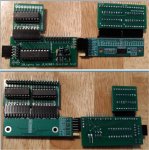lbenson
Senior Member
Hedingham's dollhouse lighting thread made me wonder about a convenient way to turn on and off lots of 12V lights on a 24-hour timed schedule. I've designed PCBs, had them manufactured, and and have tested a 20M2 design which, with an MCP23017 I2C I/O extender allows control of 29 lights, with 256 possible turn-on times with a possible duration of 4 hours, 15 minutes each.

Eagle File Schematic and PCB Images:




Eagle File Schematic and PCB Images:






